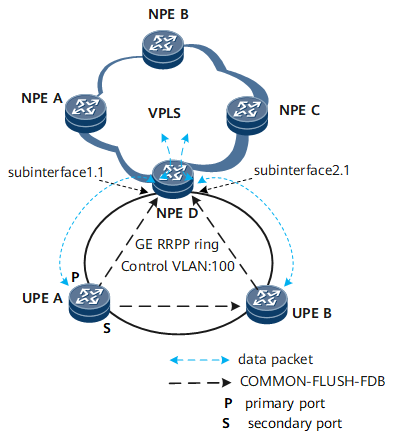Overview of RRPP
Definition
The Rapid Ring Protection Protocol (RRPP) is a link layer protocol used to prevent loops on an Ethernet ring network. Devices running RRPP exchange packets with each other to detect loops on the network and block specified interfaces to eliminate loops. RRPP snooping notifies a virtual private LAN service (VPLS) network of RRPP ring status changes.
Purpose
As shown in Figure 1, Underlayer Provider Edges (UPEs) are connected to the VPLS network where NPEs reside in the form of an RRPP ring. NPEs are connected through a PW, and therefore cannot serve as RRPP nodes to directly respond to RRPP protocol packets. As a result, the VPLS network is unaware of status changes of the RRPP ring. When the RRPP ring topology changes, each node on the VPLS network still forwards downstream data according to the entries generated before the RRPP ring topology changes. As a result, the downstream traffic cannot be forwarded.
To resolve the problem, configure RRPP snooping on sub-interfaces or VLANIF interfaces to allow the VPLS network to transparently transmit RRPP protocol packets and detect changes on the RRPP ring. When the RRPP ring is faulty, NPE D on the VPLS network synchronously clears the forwarding entries of the VSIs (including the associated VSIs) on the local node and those of the remote NPE B to re-learn forwarding entries. This ensures that traffic can be switched to a normal path and downstream traffic can be normally forwarded.
Benefits
When RRPP snooping is configured on sub-interfaces or VLANIF interfaces, the VPLS network can transparently transmit RRPP protocol packets, detect changes on the RRPP ring, and upgrade the forwarding entries to ensure that traffic is switched in time to a congestion-free path.
